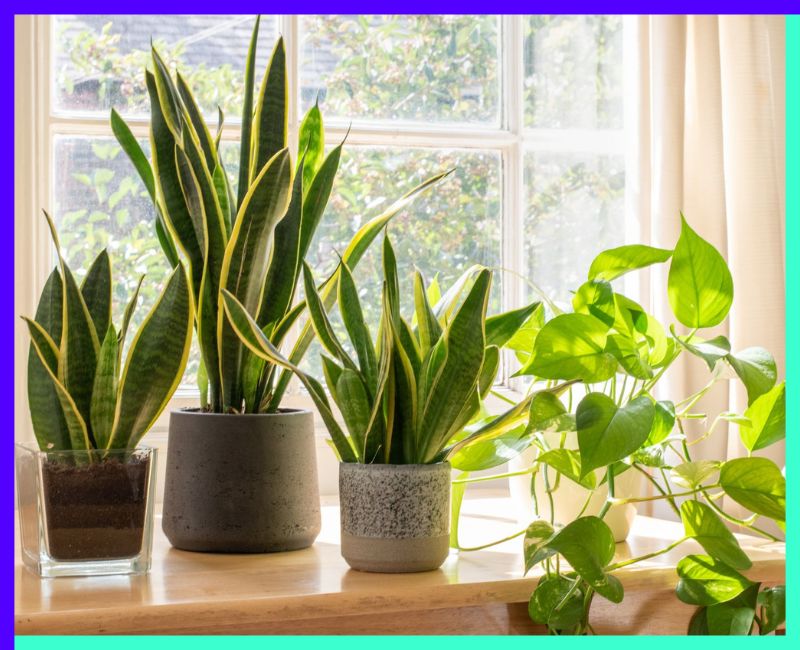Indoor plants are more than just decorative pieces; they bring a breath of fresh air to our homes, literally and figuratively. The best indoor plants not only enhance the aesthetic appeal of your space but also contribute to a healthier living environment. Whether you’re new to gardening or a seasoned plant parent, selecting the right indoor plants for your home can make all the difference. In this article, we’ll explore the top 10 indoor plants, how to care for them, and the benefits they bring to your home.
Best Indoor Plants for Your Home
When choosing indoor plants, it’s essential to consider factors like light availability, humidity levels, and your personal commitment to plant care. Here are ten indoor plants that are both easy to care for and perfect for enhancing any home:
1. Snake Plant (Sansevieria)
The Snake Plant is a resilient and low-maintenance indoor plant, making it ideal for beginners. It thrives in low light and requires minimal watering, making it perfect for those who are often away from home. Its upright leaves and striking patterns add a modern touch to any room.
2. Spider Plant (Chlorophytum comosum)
The Spider Plant is known for its air-purifying properties. It is incredibly adaptable and can thrive in various lighting conditions, from low light to bright, indirect light. It’s also pet-friendly, making it a great choice for homes with animals.
3. Peace Lily (Spathiphyllum)
Peace Lilies are not only beautiful with their glossy leaves and elegant white flowers, but they also help to purify the air. They prefer low to medium light and slightly moist soil, making them easy to care for in most indoor environments.
4. Pothos (Epipremnum aureum)
Pothos, or Devil’s Ivy, is one of the most versatile indoor plants. It can tolerate low light, but thrives in bright, indirect light, and can grow in water as well as soil. Pothos is also known for its air-purifying qualities and trailing vines that add a lush, green look to any space.
5. ZZ Plant (Zamioculcas zamiifolia)
The ZZ Plant is a hardy indoor plant that tolerates neglect well. It has shiny, dark green leaves and can survive in low light and with infrequent watering. Its striking appearance makes it a favorite among modern home decorators.
6. Rubber Plant (Ficus elastica)
The Rubber Plant has large, glossy leaves that make a bold statement in any room. It thrives in bright, indirect light and prefers to dry out between waterings. This plant is also known for its ability to remove toxins from the air.
7. Aloe Vera
Aloe Vera is not only an attractive plant but also has medicinal properties. It prefers bright, indirect light and needs minimal watering. The gel inside its leaves is known for its healing properties, particularly for burns and skin irritation.
8. Monstera Deliciosa
Monstera, or the Swiss Cheese Plant, is famous for its large, perforated leaves. It thrives in bright, indirect light and needs to be watered when the top inch of soil is dry. This plant can grow quite large, making it a stunning focal point in any room.
9. English Ivy (Hedera helix)
English Ivy is a classic indoor plant that’s easy to grow and maintain. It prefers bright, indirect light and regular watering, allowing the soil to dry out slightly between waterings. Its trailing vines add a touch of elegance to any space.
10. Fiddle Leaf Fig (Ficus lyrata)
The Fiddle Leaf Fig is known for its large, violin-shaped leaves. It prefers bright, filtered light and regular watering, with soil that dries out slightly between waterings. Though it requires a bit more attention than some other indoor plants, its striking appearance is well worth the effort.
How to Care for Indoor Plants
Caring for indoor plants is simpler than you might think. Here are some general tips to keep your indoor plants thriving:
- Light: Most indoor plants prefer bright, indirect light. However, some can thrive in low light conditions. Ensure you place your plants in a spot that matches their light needs.
- Watering: Overwatering is a common mistake. Allow the soil to dry out between waterings for most plants. The amount of water needed can vary depending on the plant and the season.
- Humidity: Many indoor plants prefer a humid environment. If your home is dry, consider misting your plants regularly or using a humidity tray.
- Fertilizing: Indoor plants benefit from regular feeding, especially during the growing season (spring and summer). Use a balanced, water-soluble fertilizer every few weeks.
- Pruning: Regular pruning helps maintain the shape and health of your plants. Remove dead or yellowing leaves to promote new growth.
Benefits of Caring for Indoor Plants
Indoor plants offer more than just visual appeal. Here are some benefits of having indoor plants in your home:
- Improved Air Quality: Many indoor plants are known for their ability to filter toxins from the air, providing a healthier living environment.
- Enhanced Mood and Productivity: Being around plants can boost your mood, reduce stress, and increase productivity. This is particularly beneficial in home offices.
- Natural Humidifiers: Plants release moisture into the air through a process called transpiration, which can help maintain humidity levels in your home.
- Aesthetic Appeal: Indoor plants can transform any space, adding color, texture, and life to your home decor.
- Health Benefits: Certain plants, like Aloe Vera, have medicinal properties that can be used for natural remedies.
Indoor Plants for a Healthier Home Environment
Selecting the best indoor plants for your home not only enhances the aesthetic appeal but also contributes to a healthier living space. By understanding the care needs of your plants and incorporating them into your daily routine, you can enjoy the numerous benefits that indoor plants offer. Whether you’re looking to improve air quality, boost your mood, or simply add a touch of nature to your home, these indoor plants are a great place to start.






